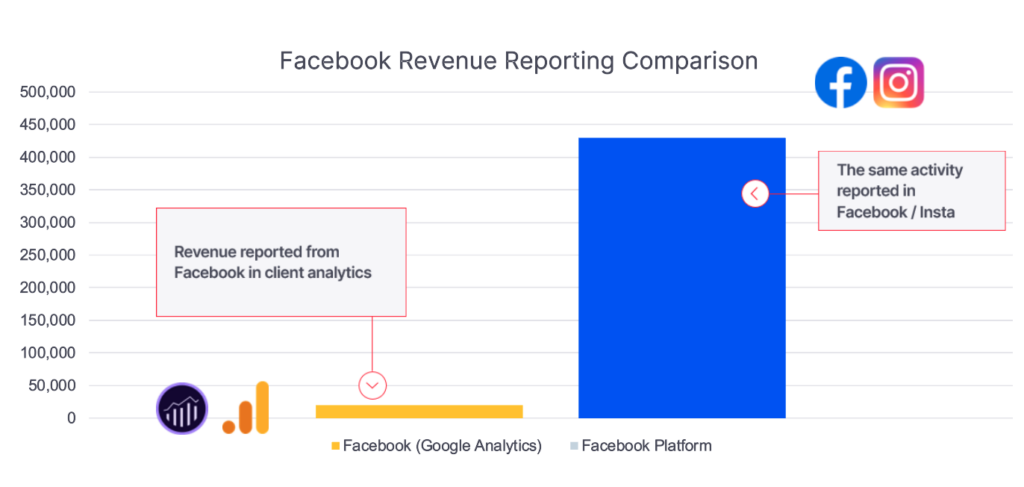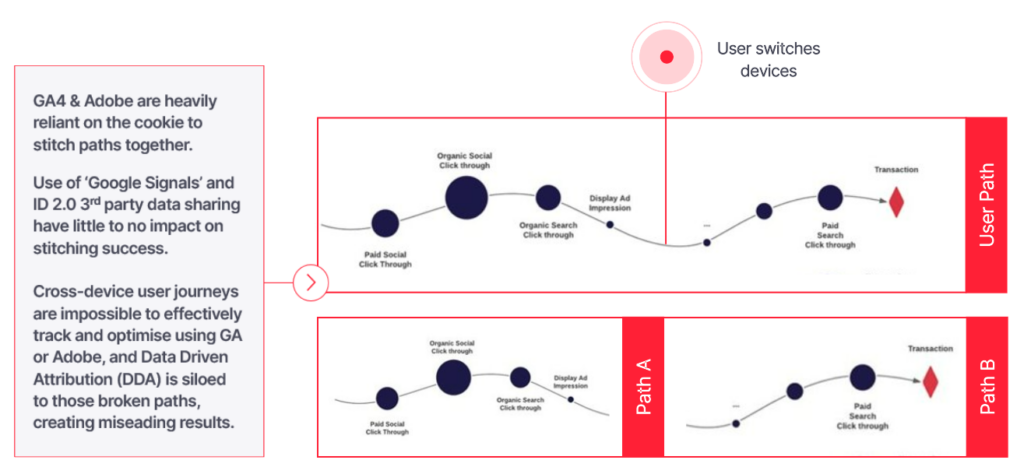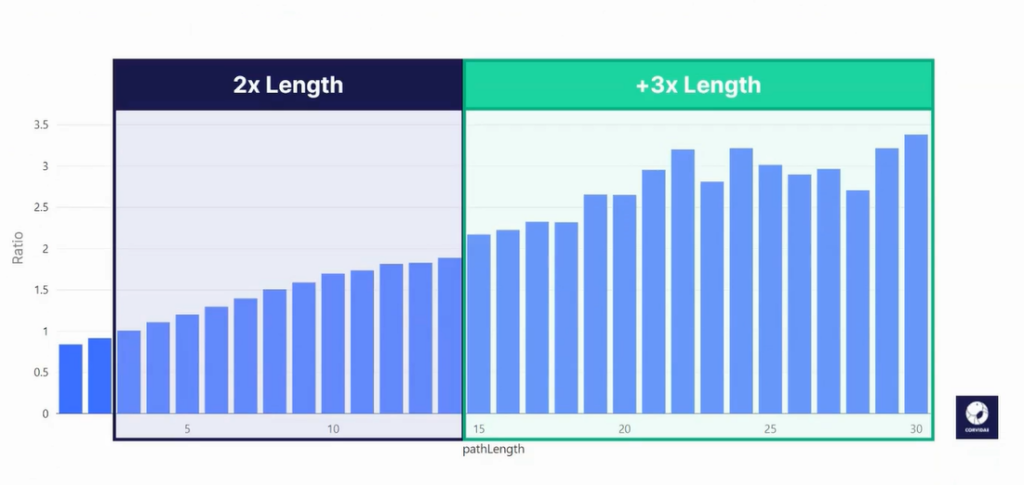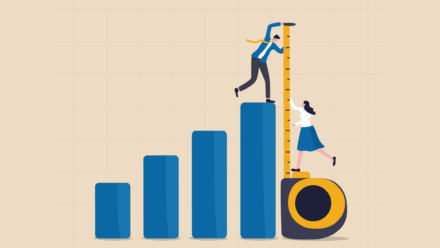How to Ditch Last Click Attribution for Greater ROI

It’s widely accepted within the marketing industry that Last Click isn’t an effective way to measure our marketing activity – but with a lack of real alternatives available, we’re often left relying on outdated techniques that damage ROI.
But is there really a better way to do marketing attribution?
In our recent webinar, CEO & Founder, Chris Liversidge, discussed why it’s time to ditch Last Click for good and explored how to unlock greater ROI by switching to AI-driven attribution.
Continue reading for an overview of the session, covering:
- Why you need to move away from Last Click
- How you can secure buy-in to move to a new attribution method
- How to double your user paths with AI-driven attribution
Access the full webinar here >>
The problem with Last Click
Chris started off the webinar with an interesting statistic from the Harvard Business Review:
73% of retail consumers use multiple channels to shop.
And as we know, our customers are engaging with lots of different channels and that user journey is becoming far more complex.
But rules-based models, such as Last Click, don’t represent the true behaviour of our customers.
To further explain this, Chris shared an example of a user journey, and how simplistic rules-based attribution models would show this in our analytics tools.

With Last Click, what we see from user journeys is only a single touchpoint in a journey that likely spans anywhere from 14 to 28, or even more, individual touchpoints with your brand across varying channels. And that single touchpoint gets weighted with the complete value of that transaction.
Related: 5 Marketing Attribution Tools for 2023
The same happens with First Click models, where all the weight and credit for a transaction is put on the very first touch point in a customer journey.
And often in marketing – and Paid Media teams, in particular – we see a blended approach.
First touch is used to represent how many potential new customers are being reached in a campaign – and particular revenue calculations are associated with that; Last Click is used for Search campaigns, as it’s seen as typically the end point for a conversion path.
But this simplistic approach doesn’t represent a real customer journey and the actual behaviour of a customer. And as a result, skews our reporting and results in a lot of wasted spend in our campaigns.
Marketing channels are increasingly siloed
Really, our attribution models are just a part of the puzzle.
The channels we use to attract and convert customers are becoming increasingly siloed – making it difficult to understand where the value sits in our marketing mix.

In the example above, which Chris shared during the session, we are trying to understand how much revenue was created from a campaign within Facebook.
However, the issue with this is that our analytics platforms, such as Google Analytics or Adobe which is represented on the left, are click-based.
Whereas Meta, including Facebook and Instagram, are impression-based.
So, they’re attributing value based on different factors: GA requires a click-through to the website where a pixel is fired to determine conversion, whereas Facebook is basing their revenue tracking on whether or not a customer completing a transaction had seen any ads from the campaign.
And when we compare those two reports, and add everything together, it becomes clear that something doesn’t add up.
A quick word on Google Analytics and Adobe Analytics…
So, from an attribution point of view, it’s clear that rules-based models don’t work. And we also know that the data from our marketing channels is siloed.
How can we try to approach something that’s getting close to representing what our customers are actually doing?
As Chris explained, this is really at the heart of what an analytics system is and why we use it.
The vast majority of us will use Google Analytics, or Adobe Analytics, for our marketing measurement. And these both use a first-party pixel to collect event stream data and a first-party cookie to associate an ID with that event.
And those are what are used to stitch together the user path – which Chris highlighted at the beginning of the webinar, and which we covered earlier in this blog.
To further explain, Chris shared that same path again but this time, added in a middle point to represent what would happen if a user switched to another device in their journey.

So, when that’s being measured using a first-party pixel and a first-party cookie, the end result is that you end up with two paths.
What does that mean, in attribution terms?
When you apply your rules-based attribution model to this path – which is now two paths – Path A would have no transaction at all and so no revenue would be associated to any of those touch points.
And Path B would be weighting, on a first-touch basis, everything to the most insignificant conversion part of that path because in fact, it’s a continuation of a previous visit and not a new unique individual.
And if we’re applying data-driven attribution to Path B, we’re applying more revenue than we actually should to the three touchpoints that are visible because we’ve excluded the the touchpoints that were in Path A.
As Chris explained:
“This is why […] when you try to move away from Last Touch in your measurement, you get results that don’t really add up.
And if you do take action on those results […] you often don’t get the outcome that you expect.”
Is there a real alternative to Last Click?
As Chris explained during the webinar, finding an attribution solution that works for marketers is a challenge we’ve been invested in for almost a decade now, here at QueryClick.
And by working with our customers, we began investigating whether AI was a viable solution for rebuilding event streams and accurately stitching an ID to another ID to create a true picture of the customer journey.
What we found, Chris shared, was that by using Machine Learning you can increase the accuracy of those event streams you see in your analytics platforms – like GA and Adobe – to boost the 20% accuracy which cookie-based systems give you up to around 85% accuracy.
Today, that number is over 95%.
So, what does that mean?
The AI within the attribution model really understands what is influencing conversion behaviour and it’s developing very accurate well stitched together conversion paths.

This chart above shows that on average those paths are at least twice as long – and typically two to three times as long as GA or Adobe paths using cookie-based sessions.
So, you are getting a real accurate picture of those paths that Chris shared at the beginning of the session.
Introducing Corvidae
Chris ended the webinar by sharing some insight into recent updates with our attribution tool, Corvidae – and important use cases for attribution.
These included:
- Attribution is key for marketing efficiency
Corvidae’s AI allows for data-driven attribution to understand which interactions ultimately lead to conversions. By using this, we were able to pinpoint campaigns where Facebook was overreporting revenue by 300%.
- Gain a better understanding of channel and campaign performance
Our scatter plot reports allow you to understand at a glance which campaigns are over- or under-performing to save wasted spend.
- Hold your Google Analytics data to account – and educate the wider business
Moving to a new way of measuring performance can cause questions across the business. So, Corvidae has a new report which highlights the discrepancies in revenue reporting from your existing analytics tools.
To learn more about how to ditch Last Click attribution for good, watch the full webinar here.
Or, download our Marketing Attribution Use Cases below.
Marketing Attribution Use Cases
Own your marketing data & simplify your tech stack.
Have you read?
I have worked in SEO for 12+ years and I’ve seen the landscape shift a dozen times over. But the rollout of generative search engines (GSEs) feels like the biggest...
As you will have likely seen, last week Google released the March 2024 Core Algorithm Update. With it, comes a host of changes aiming to improve the quality of ranking...
After a year of seemingly constant Google core updates and the increasingly widespread usage of AI, the SEO landscape is changing more quickly than ever. With this rapid pace of...



